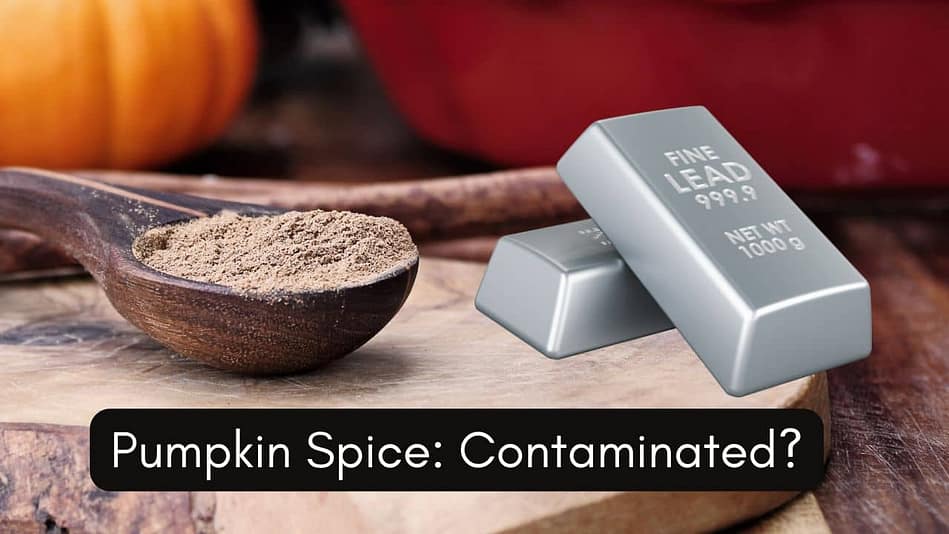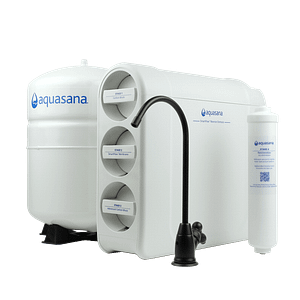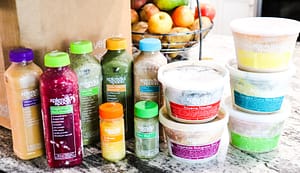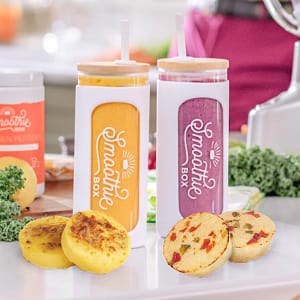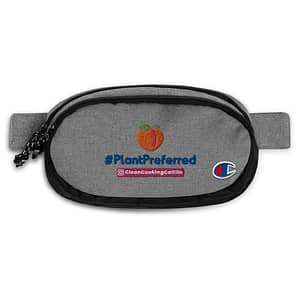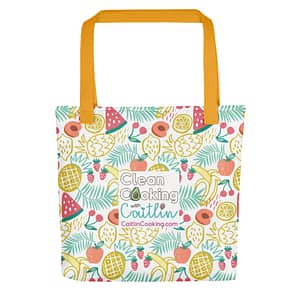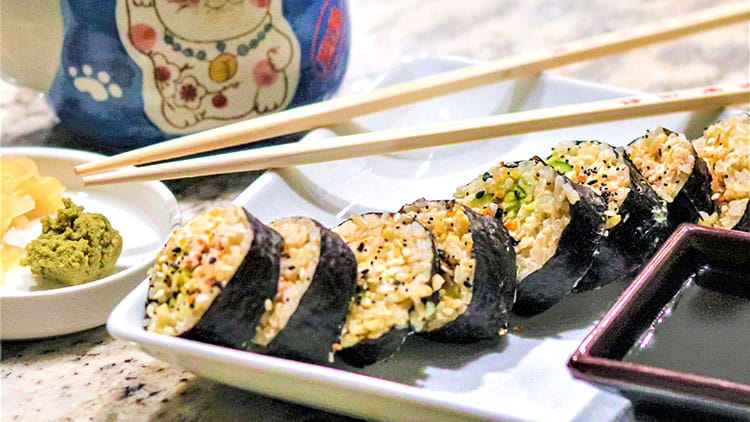Share This

Pages on this site may contain affiliate links, meaning if you book or buy something, I may earn an affiliate commission at no additional cost to you. Thank you for your support! Learn More
Also note: While I am a certified nutrition coach, I am not a medical doctor. Information here is not intended to be a replacement for the advice you should seek from your doctor.
I’ve been really into pumpkin spice this year—using the blend in my coffee and desserts! As I’m pregnant, I have an extra reason to be cautious and wonder if I should be concerned about the spices I’m using. Specifically, I started to worry about whether there’s lead in pumpkin spice blends, especially because they often contain cinnamon—a spice that has been linked to lead contamination.
With news about lead in cinnamon and other spices circulating, I decided to dig deeper. Should I be worried about what’s in pumpkin spice – which contains ground cinnamon?
What brand of pumpkin spice are you using?

What Consumer Reports Found Regarding Cinnamon
Consumer Reports recently tested 36 cinnamon and spice products and found that 12 of them had lead levels above the safe limit of 1 part per million (PPM), the threshold used by New York state to trigger a recall. These findings are particularly concerning given that many of these products are widely available in grocery stores. If consumed regularly, even small amounts of lead in these spices could pose serious health risks over time.
In this article, I’ll walk you through how to investigate whether your pumpkin spice blend might be contaminated with lead, using my own research and tools like the FDA database and Consumer Reports. Together, we’ll explore what you can do to ensure your spice blends are safe, and when you might need to be concerned about the spices in your kitchen.
Steps to Determine if There is Lead in Your Pumpkin Spice
With recent reports about lead in cinnamon and other spices, I decided to investigate whether my Spice Islands Pumpkin Pie Spice blend could be contaminated. This is something anyone can do with a few simple steps.
Here’s how you can check if your spice blend contains lead or if it’s been subject to recalls:
Step 1: Search FDA Recalls and Consumer Reports
The first thing I did was check the FDA recall database for any alerts related to lead in cinnamon or pumpkin spice. While I didn’t find anything specific to my brand, checking the database regularly is a good practice to catch any potential contamination.
Next, I turned to Consumer Reports, which had recently tested 36 cinnamon and spice products. They found that 12 of these products contained lead levels above the safe limit, with some even recalled due to contamination. Unfortunately, my pumpkin spice blend wasn’t included in the report, so I had to keep digging.
While the FDA recall database and Consumer Reports is a good starting point, it’s important to keep in mind that not all contaminated products get flagged immediately (there are plenty of reasons for this, but that’s a discussion for another time!). Spices like cinnamon can sometimes escape attention despite containing unsafe levels of lead. This is why it’s beneficial to look beyond the FDA’s guidelines and consider stricter standards, such as those set by New York, which enforce tougher limits on lead contamination in spices.
Why New York’s Strict Spice Regulations Matter
New York state has been a leader in regulating the amount of lead in food products, including cinnamon, ginger, and other spices. The state has set a maximum allowable lead level of 1 PPM for spices, which is more stringent than federal guidelines. This means that any product exceeding this limit must be removed from the shelves in New York. For consumers, purchasing lead-free cinnamon and other spices that meet these stricter standards is one way to minimize the risk of lead exposure.
Step 2: Researching Your Brand and Availability
Since I couldn’t find any concrete information about lead in Spice Islands Pumpkin Pie Spice, I decided to dig a little deeper. First, I visited the Spice Islands website to check for any mention of recalls or safety alerts. No relevant information was posted. Then, I used their “Where to Buy” feature, inputting a New York zip code (10001), knowing that New York has the strictest regulations for lead in cinnamon and other spices. I then went to those store sites and/or the store’s Instacart page to verify their actual availability.
Step 3: Cross-Check Store Listings
To verify the information I found, I turned to Instacart and searched for both the Spice Islands Pumpkin Spice blend and the Spice Islands Ground Cinnamon in stores around New York (10001). While I was able to find the pumpkin spice blend in stock for delivery, the cinnamon was still unavailable, even from major grocery chains in that area of New York like ShopRite and Fairway.
This led me to a reasonable hypothesis: perhaps the ground cinnamon contains too much lead to be sold individually in New York, but because there’s less cinnamon in the pumpkin pie spice blend, it may not breach the state’s limits. Still, this was just an educated guess based on availability.
Step 4: Making an Educated Guess
After my research, I concluded that while I couldn’t definitively prove my Spice Islands Pumpkin Pie Spice blend was safe from lead contamination, the absence of their cinnamon in New York stores gave me reason to be cautious. Since there’s far less cinnamon in a pumpkin spice blend than in pure ground cinnamon, it may not exceed the strictest safety limits, but to be safe, I’ve decided to use my blend sparingly and continue monitoring for any future recalls or alerts.
Using this approach helped me better understand the potential risks, and it’s a process anyone can follow if they’re concerned about their own spices. The more reputable information you gather, the better you can make smart decisions about what you consume!
Why You Should Be Concerned About Lead in Your Pumpkin Spice
Health Risks of Lead Exposure
Lead exposure can be dangerous for anyone, but it is particularly harmful to children and pregnant individuals. Even in small amounts, lead can build up in the body over time, causing a range of health issues.
Effects of Lead Exposure on Children
In children, lead exposure is linked to:
- Developmental delays
- Learning disabilities
- Behavioral problems
Lead disrupts brain development, which can reduce IQ, shorten attention spans, and increase the risk of behavioral disorders [WHO], [CDC], [Frontiers].
Effects of Lead Exposure on Pregnant Individuals
For pregnant individuals, lead can affect the development of the fetus, particularly the brain and nervous system. Lead exposure during pregnancy can cause:
- Miscarriage
- Premature birth
- Low birth weight
- Damage to the baby’s brain, kidneys, and nervous system
Lead stored in the bones can be released during pregnancy, raising blood lead levels and putting the fetus at risk [CDC], [NIEHS].
Long-Term Effects of Lead Exposure in Adults
In adults, long-term exposure to lead can contribute to:
- Immune system suppression
- Kidney damage
- High blood pressure
Even low levels of lead exposure can cause significant health risks over time. Monitoring lead exposure in everyday items, including food, is crucial to minimizing long-term health issues [NIEHS].
When to Be Concerned About Lead in Your Pumpkin Spice
Lead contamination in spices, particularly in products like cinnamon, can be worrying, but how much lead is too much? Let’s break down when it’s time to take extra caution.
How Lead Contaminates Spices
Lead contamination in spices can occur in a few different ways. The most common sources include:
- Soil and groundwater: Spices like cinnamon, which come from tree bark, can absorb lead from contaminated soil or groundwater over time.
- Processing and storage: Lead can also be introduced during the manufacturing process, through machinery or storage containers.
Once lead is in the spice, there’s no way to remove it. Unfortunately, spices from regions with less stringent environmental regulations may have higher levels of contamination.
How Much Lead is Harmful?
How much lead do you need to consume to really be concerned?
My Skeptical Husband
- Children: According to the Centers for Disease Control and Prevention (CDC), there is no safe blood lead level for children. Even low levels of lead in blood can affect a child’s development. The CDC defines an elevated blood lead level as 3.5 micrograms per deciliter (µg/dL) or higher (Environmental Defense Fund) .
- Adults: The Occupational Safety and Health Administration (OSHA) considers blood lead levels over 5 µg/dL in adults to be concerning. However, chronic exposure, even at lower levels, can cause significant health problems over time, such as kidney damage and high blood pressure (Martha Stewart). This is particularly important for pregnant individuals, as lead exposure during pregnancy can affect fetal development.
- Food and Spices: The U.S. Food and Drug Administration (FDA) does not have specific limits for lead in spices, but they have set a provisional tolerable total daily intake (PTTDI) for lead in adults at 12.5 micrograms per day. For children, the limit is 3 micrograms per day (Verywell Health). Even small amounts of lead from food can accumulate over time, leading to serious health effects.
- International Standards: The European Union (EU) has proposed stricter limits for lead in food and spices. For example, the maximum lead limit in certain spices, like turmeric and cinnamon, has been proposed at 2 parts per million (ppm)(Consumer Reports).
What You Can Do
If you’re concerned about lead in your spices, there are a few steps you can take:
- Use spices with low lead levels: As discussed, some brands have been tested and found to have low or negligible levels of lead. These include products like 365 Whole Foods Market Organic Cinnamon, Morton & Bassett San Francisco Organic Ground Cinnamon, or Loisa Organic Cinnamon.
- Limit your use of potentially contaminated spices: If you’re unsure whether your spices contain lead, it’s best to use them sparingly, particularly in foods that children or pregnant individuals will be eating. Note: just because it is organic, does not mean the spice is low lead.
- Stay informed: Continue monitoring recalls from the FDA and sources like Consumer Reports. This can help you stay on top of any new findings or alerts about contaminated products.
By understanding the risks of lead in spices and making informed choices about which products to use, you can significantly reduce your exposure and keep yourself and your family safe.
DIY Pumpkin Spice Blend for Extra Assurance
After digging into the research and looking at the potential risks associated with certain cinnamon products, I realized that one way to ensure safety is to make your own pumpkin spice blend. This not only allows you to control the quality of the ingredients, but it also ensures that you can use brands that have been tested and found to have low levels of lead, as highlighted by Consumer Reports.

How to Make Your Own Pumpkin Spice Blend
For those who want to avoid any uncertainty about what’s in their spice blends, here’s an easy recipe for a DIY pumpkin spice mix using low-lead cinnamon and other spices. By doing this, you can be sure you’re using ingredients that are both safe and delicious.
Why Choose Your Own Ingredients?
If you make your own blend, you have the ability to choose spices that have been independently tested and shown to have low or no detectable levels of lead. This offers peace of mind, especially if you’re someone who uses spices frequently or if you’re serving food to children or pregnant individuals who are more vulnerable to lead exposure.
Plus, when you mix your own spices, you can adjust the flavors to your preference—maybe a little extra cinnamon or ginger, depending on your taste!
This DIY blend ensures that you’re in control of what goes into your spice rack, making it a safe and flavorful alternative to store-bought blends.
Conclusion: Stay Informed and Protect Your Health
By following these steps and staying informed, you can protect yourself and your family from potential lead contamination in spices like cinnamon. It’s crucial to regularly check resources like the FDA recall database and Consumer Reports for updates on products that may be unsafe.
In my case, I decided to keep using my current bottle of pumpkin spice but with caution. I’ll be using it sparingly and keeping an eye on future recalls. Staying informed by subscribing to updates will help ensure I don’t miss important safety alerts.
If you’re concerned about the specific spices you use, purchase those that have been tested for lead contamination, such as lead-free cinnamon brands mentioned in Consumer Reports. Alternatively, you can create your own pumpkin spice blend with ingredients from trusted sources.
While not all spices are flagged right away, taking proactive steps—like researching your brand’s availability in stricter states like New York—can help you avoid potential risks. Lead in cinnamon, ginger, and other spices is a serious concern, but with the right information, you can make safer choices for you and your family.
Remember to check back for updates, especially as new reports on lead contamination emerge. Your health and peace of mind are worth the extra effort.

